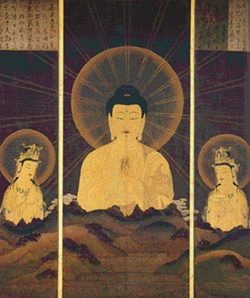Secret mantra
Jump to navigation
Jump to search
Secret mantra (Tib. sang ngak; Wyl. gsang sngags) or Secret Mantra Vajrayana (Tib. sang ngak dorje tekpa; gsang sngags rdo rje theg pa ) — another name for the Vajrayana.
His Holiness the Dalai Lama says:
- You might wonder what is meant by ‘secret mantra’. It does not mean the visualization of deities, or the recitation of mantra or the ritual practices for pacifying, enriching, magnetizing and subjugating. These are not what we call ‘secret mantra’. Nor is it the yogic practice of tsa-lung meditation.
- Secret mantra is not simply offering tormas, playing instruments like the gyaling, beating drums and doing elaborate rituals. If this were the definition of tantra, then it would follow that even Milarepa was not a tantric practitioner. He lived in a cave and had no possessions, he did not even have a bell and vajra, yet he was without question one of the greatest tantric yogis who ever lived.
- What then is the ‘mantra’ in the vehicle of secret mantra? The word mantra means that which protects the mind. Here, mantra protects the mind against ordinary perception. This is also the real meaning of ‘vajra’ in the word ‘vajra-yana’.
- In mantrayana practice, there must be an understanding of emptiness endowed with compassion, which then transforms into a deity. We then practice identifying with that deity. That is the ‘vajra’ element of vajra-yana. The real practice of secret mantra vajrayana involves generating a mind of emptiness with the heart of compassion (tong nyi nyingje’i nyingpo chen) and then transforming that very mind into the pure perception of the deity and feeling a sense of pride or confidence.
